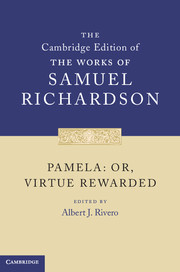Book contents
- Frontmatter
- Dedication
- Contents
- List of Illustrations
- General Editors’ Preface
- Acknowledgements
- Chronology
- List of Abbreviations
- General Introduction
- Textual Introduction
- Pamela: or, Virtue Rewarded
- Appendices
- Emendations
- Word-Division
- Bibliographical Descriptions of Early Editions
- Explanatory Notes
- Index
General Introduction
Published online by Cambridge University Press: 30 June 2022
- Frontmatter
- Dedication
- Contents
- List of Illustrations
- General Editors’ Preface
- Acknowledgements
- Chronology
- List of Abbreviations
- General Introduction
- Textual Introduction
- Pamela: or, Virtue Rewarded
- Appendices
- Emendations
- Word-Division
- Bibliographical Descriptions of Early Editions
- Explanatory Notes
- Index
Summary
Samuel Richardson's first full-length work of prose fiction, Pamela: or, Virtue Rewarded, was published anonymously on 6 November 1740 in two small duodecimo volumes; it became an instant bestseller and cultural event. Posing as ‘editor’ of a genuine correspondence, Richardson gave his readers, ‘In a Series of Familiar Letters’ (title page), the fascinating story of a young servant-girl who, withstanding the assaults of her late lady's rakish son, manages to convert him from his wicked ways and becomes his wife. Combining pious commentary with sexual titillation, and offering what its detractors affirmed was a recipe for social climbing, the novel spawned many publications, both from those who relished its religious message and from those who deplored its dubious morality. The so-called ‘Pamela controversy’, especially afterHenry Fielding joined the fray with Shamela (first published on 2 April 1741, with a second edition appearing on 3 November 1741), has often been interpreted as one of the crucial events in the development of the English novel. By May 1742, Pamela: or, Virtue Rewarded had reached its sixth edition (in octavo format, with illustrations). In an attempt to legitimize his heroine's social elevation and to reassert his right as the sole purveyor of her story, Richardson had published on 7 December 1741 a continuation in two volumes, detailing Pamela's life ‘In her Exalted Condition’. An inveterate reviser, Richardson continued to tinker with both parts of the novel for the rest of his life, with an ‘eighth edition’ (the fourth of the sequel) being published on 18 October 1761, three months after his death. A ‘new edition, being the fourteenth’, claiming to incorporate the author's final ‘corrections and alterations’ (title page), was published in four volumes in 1801. Issued by what was essentially the same group of booksellers, a ‘fifteenth’ edition, also in four volumes and with further corrections, appeared in 1810.
Such, in short, is the history of the publication of what was arguably the most influential novel published in Britain in the eighteenth century. This history, as well as the history of the novel's initial critical reception, has often been told. It is not my purpose here to rehearse either one or both of these histories in detail, but instead to offer a brief general introduction to Pamela: or, Virtue Rewarded that will outline circumstances surrounding its composition, publication, early reception, and revisions.
Information
- Type
- Chapter
- Information
- Pamela: Or, Virtue Rewarded , pp. xxxi - lxxviPublisher: Cambridge University PressPrint publication year: 2011
